Aeration is the process of poking hundreds, if not thousands of very small holes in your soil so water, oxygen and fertilizer can get into your soil more easily. Typically, a round piece of the soil, called a core or plug, is removed and left on the surface of the lawn from each place hole that is created by a handheld aeration device or motorized core aeration device. Lawn Aeration in Dallas and north Texas is most commonly done in the early spring.
Does Aerating Your Texas Lawn Really Make A Difference?
In a word yes. There are many benefits to aerating your lawn in Dallas and north Texas. Aeration promotes healthier, thicker grass by getting nutrients, water and oxygen into your soil and strengthening your turf’s root system. We have soil that has a lot of clay and sand which compacts readily. Compacted soil, commonly found in Dallas and north Texas, makes it difficult for water, nutrients and oxygen to penetrate down in to the soil to feed the root system of the lawn. We will talk more about nutrients later in this article. Aeration combined with watering twice a week also helps to protect your home’s foundation, driveway, sidewalks, and other concrete structures on your property by keeping your soil from drying out and losing nutrients. Foundation damage caused by soil expansion and compaction is very common in north Texas.
What is the Best Way to Aerate Your Texas Lawn?

The best and most common way to aerate your lawn in Dallas and north Texas is with a lawn aeration machine. A machine called a core aerator is used to pull plugs of soil, thatch and grass and eject these soil cores on the ground. This machine can be rented from a local home improvement store or you can contact your local law care company to have your lawn professionally aerated. Why do you need to poke holes in your soil? If you want to have a great looking lawn you need to have a good root system in your grass. Creating lots of holes in your soil lets it breathe so that water and other vital nutrients as well as oxygen can more easily penetrate the soil. These holes also allow the roots to more easily grow deeper and spread, strengthening your lawn’s root system. Aeration holes also provides grass seed with easy places to germinate if you plan to overseed with rye grass in the winter or cover bare spots in your lawn in the early spring.
Compacted Lawn Soil
Soil compaction happens when soil particles are pressed together tightly. The clay and sand found in north Texas soil types causes our soil to compact more easily. Heavy compaction reduces the amount of pore space between the grains of soil inhibiting your lawn’s ability to absorb oxygen, nutrients, and grow a strong root system. This process can occur when there is heavy rain or heavy traffic on the lawn. Soil compaction can be increased further by foot traffic from backyard cook-outs, kids and pets playing, as well as regular trips across the lawn to empty the trash etc. High traffic areas create paths in your lawn.
What Does a Compacted Texas Lawn Look Like?
Compacted soil looks like a pathway has been worn into the lawn. With a closer inspection, you will find that the grass is shorter than the surrounding lawn. Sometimes grass may be missing entirely with only hard dirt on the worm areas of the lawn. Samples of soil compacted paths include a walkway to a gate or outdoor living area or even from routine trips to the outside trashcans. Areas where the rain beats down from the roof, possibly in areas where there are not gutters on the house to soften the rain pouring off the roof not the awn. This soil compaction in these high traffic areas or where heavy rainfall has caused compaction may be best addressed by adding pavers or gravel paths. This solution can also be a much easier battle than aerating and continually fighting to keep grass in those high traffic areas. Soil that has suffered from driving on the grass regularly when parking in the driveway can also cause soil compaction and may even damage a sprinkler head. Placing a landscape rock or small bordered flower bed in this area can be helpful to keep vehicles from running over the grass.
What is the Best Method Of Relieving a Compacted Lawn?
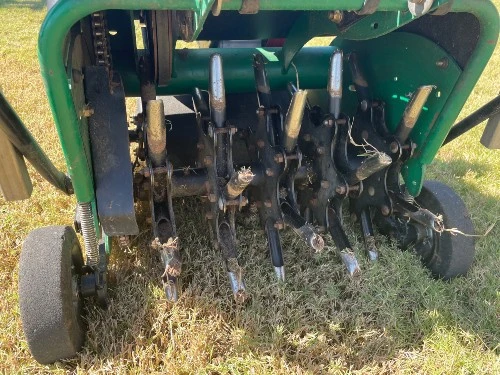
Aeration is the most common way of fixing a compacted lawn in north Texas. Problem areas of the lawn can be targeted and treated with a handheld mechanical aeration tool, a motorized core aeration machine or even a liquid lawn aerator. If the areas are widespread then a motored core aerator may be your most efficient solution. A motorized aerator will cover an area much faster than a handheld device and you may find it much easier and less expensive than trying to evenly pour a liquid lawn aerator over a wide-spread area of your lawn. Liquid lawn aeration products can also be used in conjunction with mechanical devices. However, all of these methods are designed to loosed up the non-porous soil so nutrients and oxygen can penetrate the soil more easily and stimulate healthy root growth for your lawn.
Types of Soil in Dallas and North Texas
We primarily have three types of soils in Dallas and north Texas: Blackland Prairie, Grand Prairie and Western Cross Timbers. Soil is comprised mainly of minerals, organic material, living organisms, gas, and water. Soil minerals can be divided into three types of particles: sand, silt, and clay. Soil type and traffic on your lawn are the biggest factors affecting soil compaction.
Blackland Prairie soil, also called Black Gumbo Clay soil or Cracking Clay, is the primary soil type found in lower Grayson, Collin, Dallas, Hunt, Ellis, and Kaufman counties. Eastern parts of Tarrant and Denton counties also have Blackland Prairie soil. This soil can be identified by the dark gray and black clays. It is sometimes referred as cracking clay because of the deep cracks that develop during dry weather conditions. Clay has a high expansion and shrink property that can cause havoc on your home’s foundation, driveway, sidewalks, or concrete flower bed borders. It is important to keep your lawn watered so that the expansion and contraction is minimized. If you see the soil pulling away from these areas, then you need to get water on your lawn as soon as possible. Flowing water can cause erosion which can also be a problem with this type of soil. Heavy rains are common in Dallas and other areas of North Texas. Often these hard rains are called “Texas Gulley Washers” and they can drop rain measured in inches per hour. Be sure not want to water too heavily so that you avoid flowing water across your lawn. Instead, irrigate with shorter run times with more frequency. best. No sense in paying for water that ends up being wasted as it runs off your lawn unused. Lawn core aeration will also help with absorption of the water into the soil and help control erosion. Gypsum can also be placed on the soil to loosen the clay and allow for better water absorption and air flow.
Grand Prairie soil is common in western Denton and Tarrant counties. This soil is mostly dark gray clay and may be a smaller top layer with limestone underneath. Because it is a clay-based soil, Grand Prairie soil has many of the same shrinkage-expansion issues as Blackland Prairie soil. Annual aeration and watering during dry periods will help keep the soil moist and aeration will help with erosion issues.
Western Cross Timbers soil is found in western portions of Wise, Parker and Hood counties. This soil gray/brown with slightly acidic sand or loam. The soil may also appear reddish brown along river areas, this soil is a neutral to alkaline pH. These soils are generally neutral to acidic compared to Blackland Prairie and Grand Prairie soils that are more alkaline.
Soil pH
The ideal lawn pH level is 6.0 to 7.0 for growing a thick, green lawn in Dallas and North Texas. The pH level affects the availability of nutrients to plants. These nutrients include Nitrogen, Phosphorus, Potassium, Sulphur, Calcium, Magnesium, Boron, Copper and Zinc. Often the nutrient rich topsoil may have been scraped off during the ground levelling and foundation building in the home building process. Nutrients are needed to make your lawn grow and be healthier, so it is more resistant to diseases, insects, and weeds. Fertilizer helps to replenish nutrients that have been lost in the soil. All fertilizer packaging must list three numbers. For example, 24-12-8, the first number represents the percentage by weight, of nitrogen, phosphorus, and potassium in the fertilizer. Grass clippings mulched by your mower and left on the lawn, can also provide nutrients to the lawn. To test your soil pH you can purchase PH test kits at many home improvement stores or you can buy one online. You can also have your soil tested by the Texas A&M agriculture extension (aggieturf.tamu.edu) to determine how much of each of the big three nutrients are present in your lawn.
How Do You Know if Your Texas Lawn Needs Aeration?
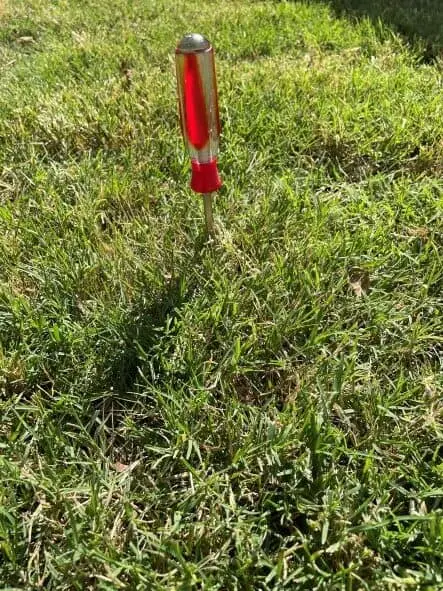
If you have patchy, struggling grass, notice water puddling or running off the lawn then soil compaction may be the cause. Testing your soil to see if it needs to be aerated is simple. Make sure your soil is moist when conducting this test. Take a screwdriver and push it into the soil and if it easily goes in 2 to 4 inches then your soil does not need aeration. If the screwdriver does not push into the ground 2 to 4 inches, then aeration is warranted. Be sure to test multiple spots in your lawn all around your home and conduct the aeration test annually. Your entire lawn may or may not require aeration. Pay extra attention to high traffic areas on your lawn.
Request a Free Quote for Lawn Aeration
Aerate Lawn Tools
There are several aeration tools available to homeowners. The cheapest option is using hand-held lawn coring tools which can be very slow and tedious especially in our clay heavy compacted soil in north Texas. There are also tow-behind plug aerators designed to attach to a riding mower or a small tractor which makes the task much easier if you own a riding mower with a hitch. Stand-alone, core aeration machines are also available, and they can often be rented at many big box home improvement stores. Although these mechanical core aeration rental units are self- propelled, they are also large and heavy. Loading and unloading can require some heavy lifting and a trailer or truck bed to haul the equipment in. Many of the lawn aerator rental units must be tilted back and turned in order to change their direction on the lawn. Be sure to schedule your rental time far in advance if possible since many other homeowners may have the same idea. Do it yourself lawn aeration can be quite a work-out. Regardless of the method you choose, below are some tips to prepare for aerating your lawn.
Core Aeration Tips
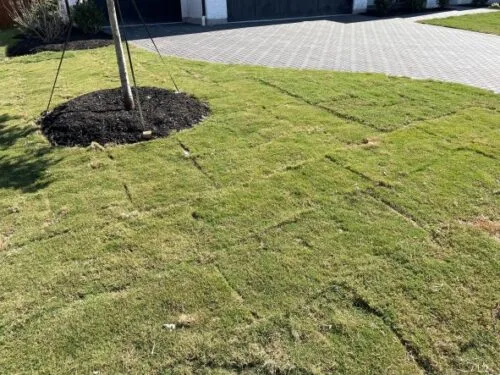
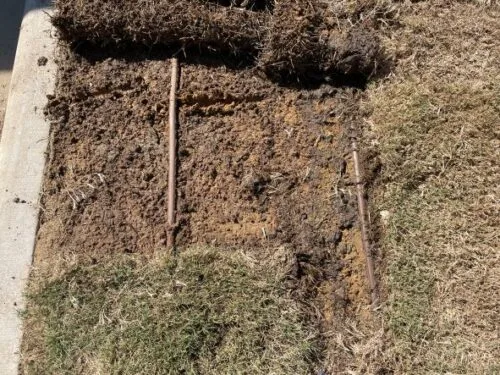
- Do not aerate a lawn that is less than one year old. Roots need to be established. New Sod will not do well with a core aeration machine.
- If DYI, then flag your sprinkler heads and valve boxes.
- Mow your lawn first to reduce the amount grass thatch left behind and allow the core spikes to penetrate your soil more deeply.
- Avoid parkways or any other areas where you have a drip irrigation system. They are buried shallow and easily to penetrate.
- After aeration, leave the plugs of soil on the lawn to decompose back into your soil.
- One final tip, after aerating the lawn is the perfect time to fertilize and water to get nutrients into your north Texas soil.
When Should I Aerate My Lawn In Texas?
The best time to aerate your lawn in Texas is in the spring. Typically March or April are the best months to aerate your lawn, when the soil temperate is not too warm, below 65 degrees. If you aerate when the soil is too hot, then you could weaken or kill the grass by drying out the roots. Save your self the work-out trying to dig holes in compacted soil and hire a professional Texas lawn care service, like Weedex, to properly aerate your lawn
Fall aeration is preferred if you are planning to overseed your lawn with winter rye grass. The practice of overseeding with winter rye has become less common in many residential communities recently. Due to weather and logistics issues, seed prices have doubled which can certainly be a deterrent from overseeding your lawn this fall.
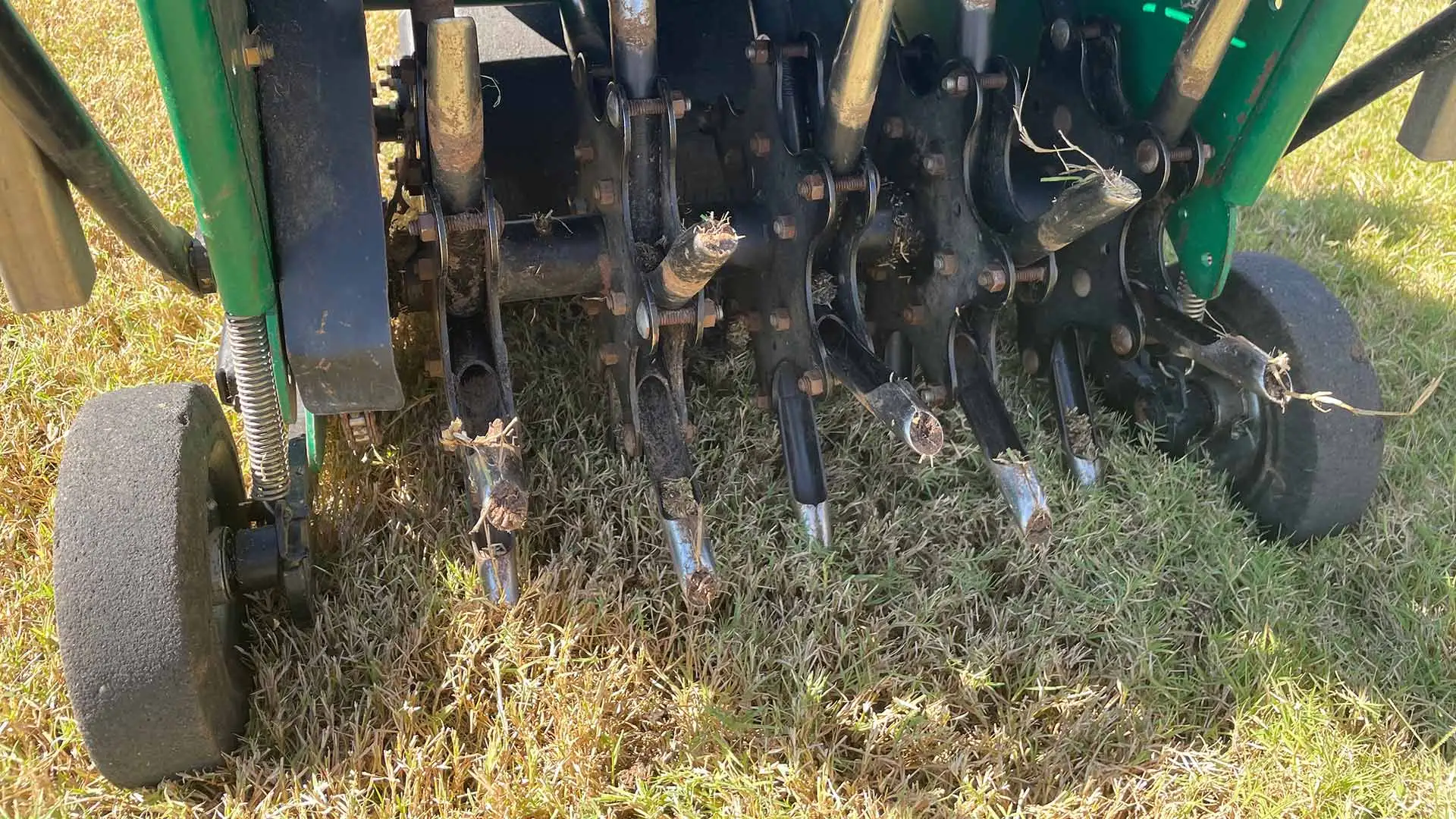

Comments (0)
Thanks for your comment!
Thanks for your feedback! Your comments have been successfully submitted! Please note, all comments require admin approval prior to display.
Error submitting comment!
There is a problem with your comment, please see below and try again.